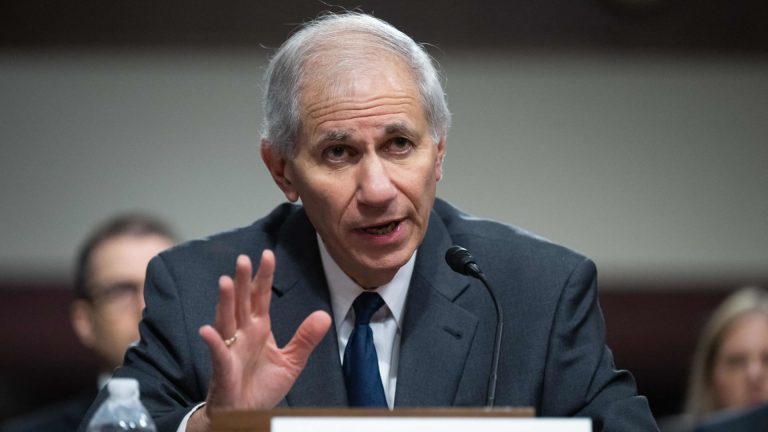
[ad_1]
Martin Gruenberg, Chair of the Federal Deposit Insurance Corporation (FDIC), testifies about recent bank failures during a US Senate Committee on Banking, House and Urban Affairs hearing on Capitol Hill in Washington, DC, May 18, 2023.
Saul Loeb | AFP | Getty Images
U.S. banking regulators on Tuesday unveiled plans to force regional banks to issue debt to protect depositors in the event of more failures.
All American banks with at least $100 billion in assets would be subject to the new requirement, which makes them hold a layer of long-term debt to absorb losses in the event of a government seizure, according to a joint notice from the Treasury, Office of the Comptroller of the Currency, Federal Reserve and Federal Deposit Insurance Corporation.
FDIC Chairman Martin Gruenberg telegraphed his intentions last month in a speech at the Brookings Institution.
Broadly, the proposal takes measures that apply to the biggest institutions — known in the industry as global systemically important banks, or GSIBs — down to the level of banks with at least $100 billion in assets. The moves were widely expected after the sudden collapse of Silicon Valley Bank in March jolted customers, regulators and executives, alerting them to emerging risks in the banking system.
That includes steps to raise levels of long-term debt held by banks, removing a loophole that allowed midsized banks to avoid the recognition of declines in bond holdings, and forcing banks to come up with more robust living wills, or resolution plans that would take effect in the event of a failure.
Regulators would also look at updating their own guidance on monitoring risks including high levels of uninsured deposits, as well as changes to deposit insurance pricing to discourage risky behavior, Gruenberg said in the Aug. 14 speech. The three banks seized by authorities this year all had relatively large amounts of uninsured deposits, which were a key factor in their failures.
Analysts have focused on the debt requirements because that is the most impactful change for bank shareholders. The point of raising debt levels is so that if regulators need to seize a midsized bank, there is a layer of capital ready to absorb losses before uninsured depositors are threatened, according to Gruenberg.
The regulators’ move will force some lenders to either issue more corporate bonds or replace existing funding sources with more expensive forms of long-term debt, Morgan Stanley analysts led by Manan Gosalia wrote in an August 28 research note.
That will further squeeze margins for midsized banks, which are already under pressure because of rising funding costs. The group could see an annual hit to earnings of as much as 3.5%, according to Gosalia.
There are five banks in particular that may need to raise a total of roughly $12 billion in fresh debt, according to the analysts: Regions, M&T Bank, Citizens Financial, Northern Trust, and Fifth Third Bancorp.
Having long-term debt on hand should calm depositors during times of distress and reduces costs to the FDIC’s own Deposit Insurance Fund, Gruenberg said last month. It also improves the chances that a weekend auction of a bank could be done without using extraordinary powers reserved for systemic risks, and gives regulators more options in that scenario, like replacing ownership or breaking up banks to sell them in pieces, he said.
“While many regional banks have some outstanding long-term debt, the new proposal will likely require issuance of new debt,” Gruenberg said. “Since this debt is long-term, it will not be a source of liquidity pressure when problems become apparent. Unlike uninsured depositors, investors in this debt know that they will not be able to run when problems arise.”
Investors in long-term bank debt will have “greater incentive” to monitor risk at lenders, and the publicly-traded instruments will “serve as a signal” of the market’s view of risk in these banks, he said.
This story is developing. Please check back for updates.
[ad_2]
Source link